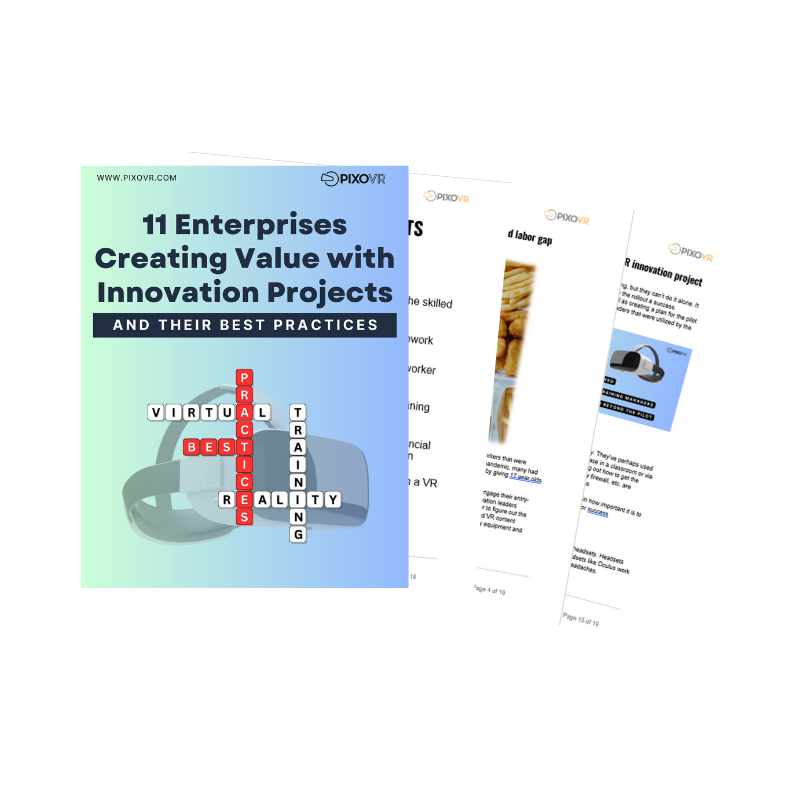11 Enterprises Creating Value with Innovation Projects
11 Enterprises Creating Value with VR Innovation Projects
And the Best Practices for Matching Their Success
Do Your Innovation Projects Impact Earnings?
One of the most common innovation projects that enterprises have launched in the past 5 years is virtual reality (VR). Unfortunately, many companies have struggled with bringing VR permanently into operations to experience the full value.
The Covid pandemic drove additional experimentation and adoption of VR in enterprises and some big success stories and clear best practices have evolved.
This whitepaper showcases VR innovation projects that are making an impact on revenue by solving the following problems:
- Reducing the skilled labor gap
- Reducing production rework
- Improving worker safety
- Reducing training costs
- Reducing financial risk
- Improving employee retention
In surfacing these success stories, we also looked at the common factors in the implementations that made them successful and compiled them into a list of seven best practices. In addition to these seven best practices, you need to have the correct mindset when it comes to virtual reality training, and achieving success with it. The key for a successful implementation is to use this as valuable training time and don’t use it as play time, or something to use up the budget. When you give VR training the value, time, and effort that it deserves, is when you will see the value. Innovation leaders can apply these best practices toward a relaunch in order to achieve the value described in this paper.
Download the whitepaper PDF
Be able to share and read the whitepaper in a PDF format

Innovation Projects That Reduced the Skilled Labor Gap

The Problem:
A global fast food chain was struggling to hire and the workers that were applying had no experience. Furthermore, thanks to the pandemic, many had never even been inside one of their restaurants. Training by giving 17 year olds a pdf manual wasn’t working. The SolutionThe innovation team felt that VR might be used to better engage their entry-level workers and train them better. To make it work, innovation leaders coordinated IT, HR, and training resources to work together to figure out the best way to introduce VR. They worked with an experienced VR content provider to develop content on how to work their proprietary equipment and started training new hires at one location. They found VR worked to engage new hires, and even attracted additional applicants through word of mouth. The time to onboard reduced and they nearly eliminated early turnover. With initial success, they began expanding to all locations—completely changing the expectations and results of entry level onboarding. |

The Problem:
The SolutionThe innovation team recommended VR to help. They found a VR content provider who already had standard VR training on the basics for field engineers like inside and outside meter inspection so they were able to get started quickly. The company was blown away by a more than 50% reduction in onboarding and a 90% reduction in the time needed for job shadowing before they became fully productive. They are continuing the program and expanding to training for existing employees. |
Innovation Projects That Reduced Rework

The Problem:
The Solution
|

The Problem:
The SolutionThe innovation team got involved and recommended trying VR training as a way for new employees to practice bagging in a life-like environment with all of the stress of needing to move quickly to keep order throughput high. They found that new employees were much more efficient when they started working and reported bagging mistakes dropped quickly. The chain is expanding the use of VR to all employees as they move to new positions. |
Innovation Projects That Improved Worker Safety

The Problem:
The SolutionTheir head of innovation recommended that their agents try using VR for job-site safety training. There was a lot of standard VR training content available for construction so they were able to easily pilot this initiative. The insurance company found a 100% higher engagement with the VR training compared to the training they were offering previously. They are also seeing a reduction in accidents, which is lowering premiums. So it’s a win-win for the insurance company and the construction companies they insure. In fact, they’ve heard from their clients that they are experiencing higher retention and productivity from their workers—building clear loyalty toward the insurance company. |

The Problem:
The Solution
|
Innovation Projects That Reduced Training Costs

The Problem:
The SolutionThe innovation team had been looking for an application to test out VR and felt this was a winner as it had the potential to eliminate those high costs. After coordinating the effort between IT, HR and training teams, with the VR content provider, they were able to create custom content to replace their training with their unique equipment. The VR content provided an experience that matched real-life. It was more effective as employees could get more practice time with the VR engines than they could with the in-person training. The company is now expanding use to other high-cost training to dramatically reduce costs while improving outcomes. |

The Problem:
The Solution
|

The Problem:
A company that manufactures building materials has hundreds of locations, frequent product design changes and high turnover. Because of this, thousands of employees are trained every week, which is a big hit to productivity.The Solution
|
Innovation Projects That Reduced Financial Risk and Improved Employee Retention

The Problem:
The SolutionThe company saw a Pwc study on how effective VR was for soft skill training and also felt this would be a positive experience in the office for when employees came in for hybrid work. There were many standard soft skill VR training courses available, so the company started with basic communication and conflict resolution training. The training allowed employees to practice difficult conversations in a safe environment and employees could watch their own avatar performance playback. Employees were blown away with how impactful the training was and at the innovative approach. The company noticed lower turnover than peer companies within a few months of rolling out the training and leadership feedback was clear that conflicts were lessened during this time period. |

The Problem:
The SolutionThe head of HR collaborated with the innovation team to give VR training a try. Instead of an uncomfortable experience, employees were able to take the training in a safe space and practice having difficult conversations with people of different genders and races. The training was able to help coach their employees on the language used and drove actionable change in gender inclusion. HR notes that complaints began rapidly decreasing, which significantly lowered financial risk. The training was so successful that the organization is looking into using VR for mindfulness training as well. |
Download the whitepaper PDF
Be able to share and read the whitepaper in a PDF format

Seven Best Practices for Success With a VR Innovation Project
Training managers play an important role in launching VR training, but they can’t do it alone. It is critical to get resources from IT and HR involved to help make the rollout a success. Innovation leaders can play a key role in helping with this as well as creating a plan for the pilot and beyond. Here are the seven best practices for Innovation leaders that were utilized by the successful innovation projects described in this paper. Companies are finding that VR training is an excellent way to assess training retention when combined with classroom, video, or e-learning materials. But VR training is also a highly effective way to train on many subjects as research studies continue to prove that learning retention is higher and time to train is shorter.
Get IT involved
Most training managers have very little exposure to technology. They’ve perhaps used Learning Management platforms, but most instruction takes place in a classroom or via pre-recorded videos. Purchasing headsets and content, figuring out how to get the content onto the headsets, testing out use outside the company firewall, etc. are daunting challenges without the help of appropriate IT resources. Innovation leaders need to get IT leadership involved and explain how important it is to the company to get VR working. need to get technology set up for success
Get corporate technology
A common mistake early VR adopters make is buying the wrong headsets. Headsets that are made for gaming are not ideal for corporate use, and headsets like Oculus work in a very isolated architecture that causes IT departments major headaches. It is critical to ensure that IT obtains headsets that are agnostic and made for corporate use cases. Pico and Vive are solid headsets for corporate use, but make sure that IT works with the VR content provider to determine the best technology for your unique environment. Beyond headsets, there is VR software that can host the content, wirelessly deliver it to headsets, monitor usage and results, and integrate with Learning Management Systems. This investment is critical to making VR a success and to making it a part of training operations.
Choose a strong use case
There are many use cases for VR in corporate environments. To increase the chance of success, choose a use case that has clear and measurable ROI. For many companies this is hard skill training where training costs are high due to travel or having to ship expensive equipment. This also may require custom content for proprietary processes or equipment. Another common starter application is safety training. Here there is more standard content available so it may be a good choice if the company is worried about the investment in custom content for a pilot. Don’t hesitate to consider the employee group being trained and the leadership as to how willing they are to try VR. It may be that gender inclusion training for office workers may be a great first choice. To make a determination, consider bringing business unit leaders together to discuss training needs and work with a VR content provider to discuss options.
Select the right content
Now that there are standard options for many training courses, it is important to select the most effective and relevant content. Preferably content that has been already proven by other companies. Look for a VR content provider with a wide selection of content who can advise on the most effective courses. Of course, standard content may not always be a fit. Ensure the VR content provider you work with can customize standard content to make the tweaks that fit your unique way of work. And if fully custom content is needed, be sure you are working with a provider who has experience working with similar corporations and knows how to effectively manage the process to make it as frictionless as possible.
Get HR involved
If training reports into HR, they will of course be involved. But HR resources are critical to VR success in other ways. The internal communications team should be enlisted to help educate employees on the VR project. They need to communicate why the company is exploring VR and the value you are trying to achieve. They can also help in rollout to build excitement and collect feedback. They should ask for testimonials from employees on their experience and share that with the company. This is especially important if an earlier project with VR failed. The more forethought and effort on this, the more successful the company will be at adopting VR and realizing value.
Incentivize training managers
Using VR for training is completely different than how training managers deliver training today. If they have no incentive to put in the work to figure out this new technology they will revert back to the way they’ve been training. Incentives can be monetary or they could be part of performance objectives. Something that PIXO VR offers is their certified virtual reality trainer program. By administering training sessions in virtual reality with PIXO, you will acquire certification based on the total number of sessions tendered. Tying their success to the successful launch of VR is key to the company rapidly seeing value instead of floundering.
Create a plan beyond the pilot
VR isn’t just a passing fad to test out. It has clearly been proven to be a highly effective addition to corporate training programs. Innovation leaders need to push for planning to go beyond pilot applications and to consider the phases of rolling out VR training to more employees and more use cases. Having a long term plan to continue to grow and mature with VR training use cases provides a path for the company to follow. Add clear milestones and tie them into performance objectives so that the company can expand value.
If you are interested in learning more about PIXO’s certified VR training program, please click here. Along with the certified training program, PIXO provides a great guide about how to roll out VR training into your business. You can find that whitepaper here.
Download the whitepaper PDF
Be able to share and read the whitepaper in a PDF format

VR Innovation Is a Strong Investment
These 11 examples of successful implementations of VR thanks to innovation teams is proof that VR can be successful and make a big impact on the business. The key is educating on long term value and coordinating the right resources together to handle this change. IT needs to be involved to help support this new technology. Training needs to buy-in to the value and the more strategic role they will play in the company. And HR needs to support rollout with employee education and promotion. When these resources work together, innovation investment yields big returns.
If you’ve already tried a VR innovation project, but it didn’t pan out, perhaps it’s time to try again with these best practices and inspirational proof from the examples above. Remember to have the correct mindset when it comes to VR training. When you give VR training the value, time, and effort that it deserves, is when you will see the value because if you don’t get started with VR, the competition will quickly gain an advantage.
About PIXO VR
PIXO’s Extended Reality (XR) platform streamlines the management of an enterprise’s training program, making it worry-free for training directors. In one step, enterprises select, manage, deploy and track training content and users globally to thousands of devices with PIXO. With our vast offering of off-the-shelf VR Training Content, the ability to create custom content for your specific needs and integration of our platform to your LMS, PIXO makes it simple to run and scale your XR training program. Headquartered in Royal Oak, Michigan, the PIXO mission is to unlock human potential and improve lives through the power of emerging technology.